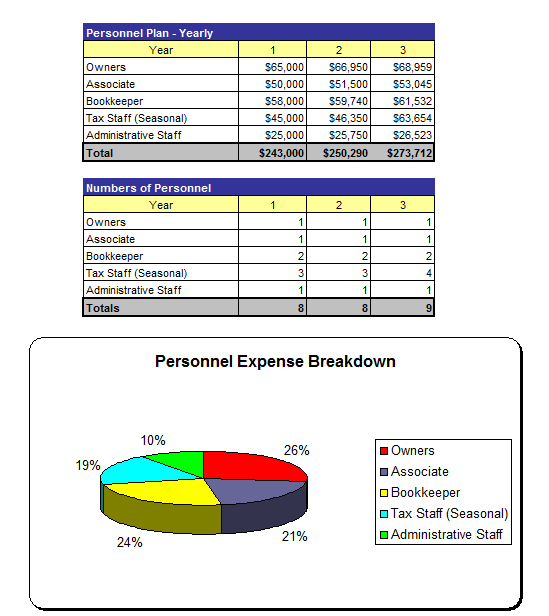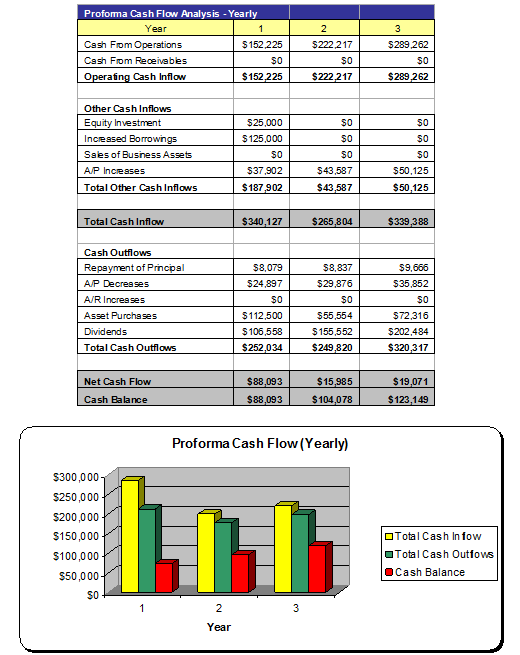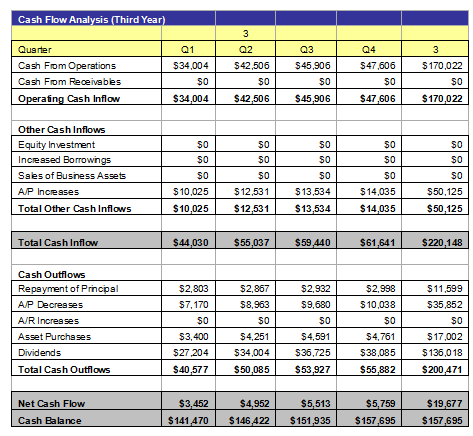Free Used Book Store Business Plan
For Raising Capital from Investors, Banks, or Grant Companies!
Please note that the financials
in this complete free business plan are completely fictitious and may not
match the text of the business plan below. This free business plan demonstration
purposes only. If you are interested in purchasing the completed editable MS Word
and Excel documents for this business plan, please click the button below! Also,
the text of the business plan is formatted with a fully automated
table of contents.
Return to
Samples Page
It should be noted that there is no special software required to use these
templates. All business plans come in Microsoft Word and Microsoft Excel format.
Each business plan features:
- Excecutive Summary
- Company and Financing Summary
- Products and Services Overview
- Strategic Analysis with current research!
- Marketing Plan
- Personnel Plan
- 3 Year Advanced Financial Plan
- Expanded Financial Plan with Monthly Financials
- Loan Amortization and ROI Tools
- FREE PowerPoint Presentation for Banks, Investors,
or Grant Companies!
1.0 Executive Summary
The purpose of this business plan is to raise $125,000 for the development of a used book store while showcasing the expected financials and operations over the next three years. The Used Book Store, Inc. (“the Company”) is a New York based corporation that will provide sales of used book inventories as well as a limited café service within its retail location. The Company was founded in 2009 by John Doe.
1.1 Products and Services
As stated above, the primary revenue source for the business will come from the sale of used books, which Management will acquire in bulk from estate sales and people looking to sell their book collections. Management expects that it will acquire these inventories at prices that are 35% of their retail value. The second revenue stream of the business will come from the sale of coffee products that will be sold within the Used Book Store. This business model is akin to that of Borders or Barnes and Noble for people that want to browse, but not necessarily purchase a book. The third section of the business plan will further describe the services offered by the Used Book Store.
1.2 The Financing
Mr. Doe is seeking to raise $125,000 from as a bank loan. The interest rate and loan agreement are to be further discussed during negotiation. This business plan assumes that the business will receive a 10 year loan with a 9% fixed interest rate.
1.3 Mission Statement
Management’s mission is to develop the Used Book Store into a premier local location that features a huge inventory of used books, a quality café, and a forum for the local community.
1.4 Mangement Team
The Company was founded by John Doe. Mr. Doe has more than 10 years of experience in the retail management industry. Through his expertise, he will be able to bring the operations of the business to profitability within its first year of operations.
1.5 Sales Forecasts
Mr. Doe expects a strong rate of growth at the start of operations. Below are the expected financials over the next three years.

1.6 Expansion Plan
The Founder expects that the business will aggressively expand during the first three years of operation. Mr. Doe intends to implement marketing campaigns that will effectively target individuals within the target market.
2.0 Company and Financing Summary
2.1 Registered Name and Corporate Structure
Used Book Store, Inc. The Company is registered as a corporation in the State of New York.
2.2 Required Funds
At this time, the Used Book Store requires $125,000 of debt funds. Below is a breakdown of how these funds will be used:

2.3 Investor Equity
Mr. Doe is not seeking an investment from a third party at this time.
2.4 Management Equity
John Doe owns 100% of the Uses Book Store, Inc.
2.5 Exit Strategy
If the business is very successful, Mr. Doe may seek to sell the business to a third party for a significant earnings multiple. Most likely, the Company will hire a qualified business broker to sell the business on behalf of the Used Book Store. Based on historical numbers, the business could fetch a sales premium of up to 4 to 6 times the previous year’s earnings depending on the strength and regularity of the Used Book Store’s income.
3.0 Products and Services
Below is a description of the used book and café products offered by the Used Book Store.
3.1 Sales of Used Books
As stated in the executive summary, the Company’s primary purpose is to acquire inventories of used books from estate sales, new book retailer divestitures, and people simply seeking to sell their book collections. The Company will pay approximately 30% to 35% of the resale value of the book to the seller. At the onset of operations, Management intends to have approximately 20,000 books within its inventory. At this time, Management is sourcing specialized software that will allow the business to easily categorize its inventories of used books while concurrently acting as a point of sale system.
3.2 Café Operations
One of the most common trends in the book retailing industry is to maintain a section of the retail location that services coffee and small food products. Barnes and Noble and Borders have both capitalized heavily on this trend as people who come to the store to browse, but not necessarily to buy, will often purchase a beverage or small snack while looking at merchandise. The margins earned from this segment of the business are tremendous, and it will ensure the profitability of the business from the onset of operations. Mr. Doe is currently looking into acquiring the licensure to serve coffee and small food items to the general public.
4.0 Strategic and Market Analysis
4.1 Economic Outlook
This section of the analysis will detail the economic climate, the book retailing industry, the customer profile, and the competition that the business will face as it progresses through its business operations. Currently, the economic market condition in the United States is in recession. This slowdown in the economy has also greatly impacted real estate sales, which has halted to historical lows. Many economists expect that this recession will continue until mid-2009, at which point the economy will begin a prolonged recovery period. However, used book stores tend to operate with a significant amount of economic stability (especially those with cafes) as the prices for books are lower than their new book retailing competitors.
4.2 Industry Analysis
Used and new book retailers generate $19 billion dollars of revenue per year. Based on information provided by the US economic census; used book stores generate approximately 10% of aggregate receipts among book retailers. The industry has grown significantly over the past ten years as major retailers like Borders and Barnes and Noble have integrated cafes and other amenities into their locations, which position the stores more as a community forum. The industry employs more than 150,000 people, and payrolls in each of the last five years have exceeded $2 billion dollars. The future expected growth rate of the industry is expected to mirror that of the general economy and population growth.
4.3 Customer Profile
In this section of the analysis, you should describe the type of customer you are seeking to acquire. These traits include income size, type of business/occupation; how far away from your business is to your customer, and what the customer is looking for. In this section, you can also put demographic information about your target market including population size, income demographics, level of education, etc.
4.4 Competitive Analysis
This is one of the sections of the business plan that you must write completely on your own. The key to writing a strong competitive analysis is that you do your research on the local competition. Find out who your competitors are by searching online directories and searching in your local Yellow Pages. If there are a number of competitors in the same industry (meaning that it is not feasible to describe each one) then showcase the number of businesses that compete with you, and why your business will provide customers with service/products that are of better quality or less expensive than your competition.
5.0 Marketing Plan
The Used Book Store intends to maintain an extensive marketing campaign that will ensure maximum visibility for the business in its targeted market. Below is an overview of the marketing strategies and objectives of the Used Book Store.
5.1 Marketing Objectives
-
• Implement a local campaign with the Company’s targeted market via the use of flyers, local newspaper advertisements, and word of mouth advertising.
-
• Establish relationships with companies that specialize in the liquidation of new book inventories.
-
5.2 Marketing Strategies
Management intends on using a number of strategies that will create immediate visibility of the Used Book Store at the onset of operations. Foremost, Mr. Doe intends to source a highly visible retail location that will ensure that the business receives a significant amount of visibility from vehicles and passers-by. During the first two months of operation, the Company will have grand opening materials that will be prominently displayed as part of the Used Book Store’s signage. The Company will also regularly host open microphone nights, poetry readings, author visits, and other community events. This will ensure a significant amount of foot traffic to the business, which will further drive both sales of used books and café sales. At the onset of operations, Management will distribute flyers and circulars to local book clubs while concurrently informing local libraries of the business’ opening. Finally, Mr. Doe will develop and register a website that will showcase the Company’s location, relevant contact information, inventory of used books, and scheduling of community events hosted by the Used Book Store. In time, this website may feature functionality that would allow customers to order a used book in stock in an e-commerce capacity. This could substantially increase the volume of the business. The website will also provide information regarding the sale of used book inventories to the Used Book Store.
5.3 Pricing
In this section, describe the pricing of your services and products. You should provide as much information as possible about your pricing as possible in this section. However, if you have hundreds of items, condense your product list categorically. This section of the business plan should not span more than 1 page.
6.0 Organizational Plan and Personnel Summary
6.1 Corporate Organization

6.2 Organizational Budget

6.3 Management Biographies
In this section of the business plan, you should write a two to four paragraph biography
about your work experience, your education, and your skill set. For each owner or
key employee, you should provide a brief biography in this section.
7.0 Financial Plan
7.1 Underlying Assumptions
-
• The Used Book Store will have an annual revenue growth rate of 10% per year.
-
• The Owner will acquire $125,000 of debt funds to develop the business.
-
• The loan will have a 10 year term with a 9% interest rate.
7.2 Sensitivity Analysis
The Company’s revenues are moderately sensitive to changes in the general economy. During times of economic recession, customers will have less discretionary income. However, going to a book store is a form of entertainment for many people, and by providing coffee beverages (at a very low pricing point), the Company will be able to maintain profitability despite deleterious changes in the economy,
7.3 Source of Funds

7.4 General Assumptions

7.5 Profit and Loss Statements

7.6 Cash Flow Analysis

7.7 Balance Sheet
 .
.
7.8 General Assumptions

7.9 Business Ratios

Expanded Profit and Loss Statements




Expanded Cash Flow Analysis



